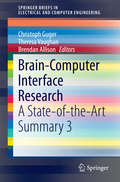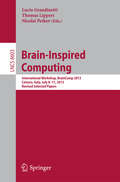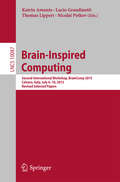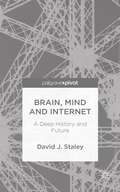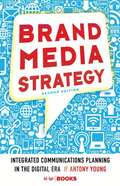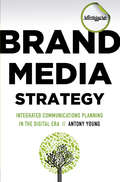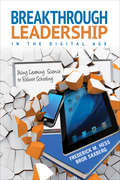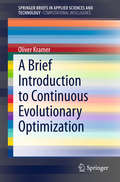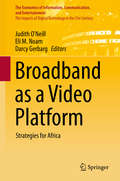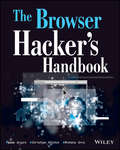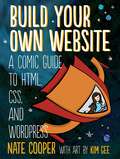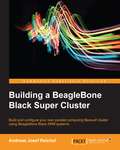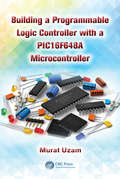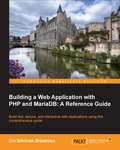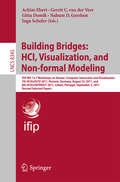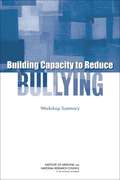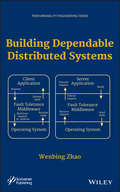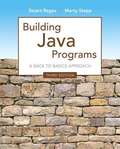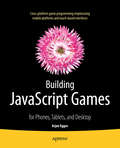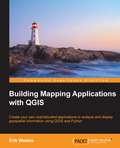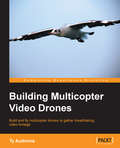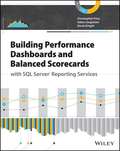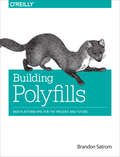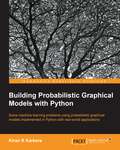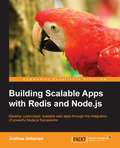- Table View
- List View
Brain-Computer Interface Research: A State-of-the-Art Summary 3 (SpringerBriefs in Electrical and Computer Engineering #6)
by Brendan Allison Christoph Guger Theresa VaughanThis book provides a cutting-edge overview of the latest developments in Brain-Computer-Interfaces (BCIs), reported by leading research groups. As the reader will discover, BCI research is moving ahead rapidly, with many new ideas, research initiatives, and improved technologies, e. g. BCIs that enable people to communicate just by thinking - without any movement at all. Several different groups are helping severely disabled users communicate using BCIs, and BCI technology is also being extended to facilitate recovery from stroke, epilepsy, and other conditions. Each year, hundreds of the top BCI scientists, engineers, doctors, and other visionaries compete for the most prestigious honor in the BCI research community: the annual BCI Award. The 2013 BCI Award competition was by far the most competitive, with over 160 research groups vying for a nomination. The chapters of this book summarize the ten projects that were nominated, in particular the winning project, and analyses how these reflect general trends in BCI development. Each project summary includes an introduction, description of methods, results, and also includes newer work completed after the project was entered for the competition. The texts are presented in accessible style with numerous supporting pictures, graphs, and figures.
Brain-Inspired Computing: International Workshop, BrainComp 2013, Cetraro, Italy, July 8-11, 2013, Revised Selected Papers (Lecture Notes in Computer Science #8603)
by Lucio Grandinetti Thomas Lippert Nicolai PetkovThis book constitutes the thoroughly refereed conference proceedings of the International Workshop on Brain-inspired Computing, BrainComp 2013, held in Cetraro, Italy, in July 2013. The 16 revised full papers were carefully reviewed and selected from numerous submissions and cover topics such as brain structure and function as a neuroscience perspective, computational models and brain-inspired computing, HPC and visualization for human brain simulations.
Brain-Inspired Computing: Second International Workshop, BrainComp 2015, Cetraro, Italy, July 6-10, 2015, Revised Selected Papers (Lecture Notes in Computer Science #10087)
by Lucio Grandinetti Thomas Lippert Nicolai Petkov Katrin AmuntsThis book constitutes the thoroughly refereed conference proceedings of the International Workshop on Brain-inspired Computing, BrainComp 2013, held in Cetraro, Italy, in July 2013. The 16 revised full papers were carefully reviewed and selected from numerous submissions and cover topics such as brain structure and function as a neuroscience perspective, computational models and brain-inspired computing, HPC and visualization for human brain simulations.
Brain, Mind and Internet: A Deep History and Future
by David J. StaleyThis essay places the emerging brain-Internet interface within a broad historical context: that the Internet represents merely the next stage in a very long history of human cognition whereby the brain couples with symbolic technologies. Understanding this 'deep history' provides a way to imagine the future of brain-Internet cognition.
Brand Media Strategy
by Antony YoungToday's sophisticated media landscape offers more tools and platforms, for the savvy marketer than ever before. Media & brand expert Antony Young explores how today's most innovative marketers are meeting the challenge by employing the latest media tools in ways never before seen to grow their brands, and getting unprecedented results.
Brand Media Strategy: Integrated Communications Planning in the Digital Era
by A. YoungToday's sophisticated media landscape offers more tools and platforms, for the savvy marketer than ever before. Media & brand expert Antony Young explores how today's most innovative marketers are meeting the challenge by employing the latest media tools in ways never before seen to grow their brands, and getting unprecedented results.
Breakthrough Leadership in the Digital Age: Using Learning Science to Reboot Schooling
by Frederick M. Hess Dr Bror V. SaxbergReboot student learning the right way! Today’s most successful school leaders are truly “learning engineers”: creative thinkers who redefine their problems and design new ways to better serve kids’ success. Technology has a critical role, but it’s the creative reinvention of schools, systems, and classrooms that has to come first. In this powerful book, best-selling author and education policy expert Rick Hess and chief learning officer Bror Saxberg show you how to become your school's learning engineer. Using cutting-edge research about learning science as a framework, you’ll: Identify specific learning problems that need solving Devise smarter ways to address them Implement technology-enabled, not technology-driven, solutions
A Brief Introduction to Continuous Evolutionary Optimization (SpringerBriefs in Applied Sciences and Technology)
by Oliver KramerPractical optimization problems are often hard to solve, in particular when they are black boxes and no further information about the problem is available except via function evaluations. This work introduces a collection of heuristics and algorithms for black box optimization with evolutionary algorithms in continuous solution spaces. The book gives an introduction to evolution strategies and parameter control. Heuristic extensions are presented that allow optimization in constrained, multimodal and multi-objective solution spaces. An adaptive penalty function is introduced for constrained optimization. Meta-models reduce the number of fitness and constraint function calls in expensive optimization problems. The hybridization of evolution strategies with local search allows fast optimization in solution spaces with many local optima. A selection operator based on reference lines in objective space is introduced to optimize multiple conflictive objectives. Evolutionary search is employed for learning kernel parameters of the Nadaraya-Watson estimator and a swarm-based iterative approach is presented for optimizing latent points in dimensionality reduction problems. Experiments on typical benchmark problems as well as numerous figures and diagrams illustrate the behavior of the introduced concepts and methods.
Broadband as a Video Platform: Strategies for Africa (The Economics of Information, Communication, and Entertainment)
by Eli M. Noam Judith O'Neill Darcy GerbargThis volume features contributions from a conference held in Lusaka, Zambia, to explore the role and prospects of broadband in Africa as a video platform--with emphasis on the strategies and building blocks for deployment and advancement. While it may seem that such networks and their applications are not a realistic scenario for developing countries, it would be short-sighted and economically dangerous to ignore the emerging trends. The pace of introduction of next-generation networks in industrialized countries is rapid and the developing world will not be able to stand aside. The risks of falling behind are great and in any country there will be elements of business and society who wish to forge ahead. Policymakers and network architects need to be prepared. Media companies and broadcasters, in particular, must be alert to the new developments as should be medical and educational institutions. The availability of advanced high-speed business application tools in a country will affect its participation in international transactions and its economic growth. This volume features contributions from industry leaders, policymakers and scholars, representing a variety of perspectives, including technology and infrastructure management, economic development, marketing, education and health. The authors collectively discuss how broadband deployment as a platform with sufficient speed for video may be encouraged by public policy and regulation and how investment in broadband for this and related purposes can improve the quality of life and experience in Sub Saharan Africa in media and data, while being a financeable, commercially sound business.
The Browser Hacker's Handbook
by Wade Alcorn Christian Frichot Michele OrruHackers exploit browser vulnerabilities to attack deep within networks The Browser Hacker's Handbook gives a practical understanding of hacking the everyday web browser and using it as a beachhead to launch further attacks deep into corporate networks. Written by a team of highly experienced computer security experts, the handbook provides hands-on tutorials exploring a range of current attack methods. The web browser has become the most popular and widely used computer "program" in the world. As the gateway to the Internet, it is part of the storefront to any business that operates online, but it is also one of the most vulnerable entry points of any system. With attacks on the rise, companies are increasingly employing browser-hardening techniques to protect the unique vulnerabilities inherent in all currently used browsers. The Browser Hacker's Handbook thoroughly covers complex security issues and explores relevant topics such as: Bypassing the Same Origin Policy ARP spoofing, social engineering, and phishing to access browsers DNS tunneling, attacking web applications, and proxying-all from the browser Exploiting the browser and its ecosystem (plugins and extensions) Cross-origin attacks, including Inter-protocol Communication and Exploitation The Browser Hacker's Handbook is written with a professional security engagement in mind. Leveraging browsers as pivot points into a target's network should form an integral component into any social engineering or red-team security assessment. This handbook provides a complete methodology to understand and structure your next browser penetration test.
Build Your Own Website: A Comic Guide to HTML, CSS, and WordPress
by Nate CooperBuild Your Own Website is a fun, illustrated introduction to the basics of creating a website. Join Kim and her little dog Tofu as she learns HTML, the language of web pages, and CSS, the language used to style web pages, from the Web Guru and Glinda, the Good Witch of CSS.Once she figures out the basics, Kim travels to WordPress City to build her first website, with Wendy, the WordPress Maven, at her side. They take control of WordPress® themes, install useful plugins, and more.As you follow along, you’ll learn how to:–Use HTML tags–Make your site shine with CSS–Customize WordPress to fit your needs–Choose a company to host your site and get advice on picking a good domain nameThe patient, step-by-step advice you’ll find in Build Your Own Website will help you get your website up and running in no time. Stop dreaming of your perfect website and start making it!
Building a BeagleBone Black Super Cluster
by Andreas Josef ReichelIf you are a programmer, scientist, or someone interested in modern computer technology that goes beyond the typical PC, then this book will show you the outstanding possibilities of cluster computing with modern embedded systems based on ARM architecture. Whether you need a high-speed or low-cost scalable cluster for simulations or want to try something new, this book is the right guide for you.
Building a Programmable Logic Controller with a PIC16F648A Microcontroller
by Murat UzamProgrammable logic controllers (PLCs) are extensively used in industry to perform automation tasks, with manufacturers offering a variety of PLCs that differ in functions, program memories, and the number of inputs/outputs (I/O). Not surprisingly, the design and implementation of these PLCs have long been a secret of manufacturers. Unveiling the mysteries of PLC technology, Building a Programmable Logic Controller with PIC16F648A Microcontroller explains how to design and use a PIC16F648A-microcontroller-based PLC. The author first described a microcontroller-based implementation of a PLC in a series of articles published in Electronics World magazine between 2008 and 2010. This book is based on an improved version of the project, including:Updates to the hardware configuration, with a smaller CPU board and two I/O extension boards that now support 16 inputs and 16 outputs instead of 8An increased clock frequency of 20 MHzImprovements to several macrosFlowcharts to help you understand the macros (functions)In this book, the author provides detailed explanations of hardware and software structures. He also describes PIC Assembly macros for all basic PLC functions, which are illustrated with numerous examples and flowcharts. An accompanying CD contains source files (.ASM) and object files (.HEX) for all of the examples in the book. It also supplies printed circuit board (PCB) (Gerber and .pdf) files so that you can have the CPU board and I/O extension boards produced by a PCB manufacturer or produce your own boards.Making PLCs more easily accessible, this unique book is written for advanced students, practicing engineers, and hobbyists who want to learn how to build their own microcontroller-based PLC. It assumes some previous knowledge of digital logic design, microcontrollers, and PLCs, as well as familiarity with the PIC16F series of microcontrollers and w
Building a Web Application with PHP and MariaDB: A Reference Guide
by Sai Srinivas SriparasaThis is a step-by-step, tutorial guide designed to help readers transition from beginners to more experienced developers using clear explanations. The variety of examples will help readers build, secure, and host real-time web applications. If you are a developer who wants to use PHP and MariaDB to build web applications, this book is ideal for you. Beginners can use this book to start with the basics and learn how to build and host web applications. Seasoned PHP Developers can use this book to get familiar with the new features of PHP 5.4 and 5.5, unit testing, caching, security, and performance optimization.
Building Bridges: IFIP WG 13.7 Workshops on Human–Computer Interaction and Visualization: 7th HCIV@ECCE 2011, Rostock, Germany, August 23, 2011, and 8th HCIV@INTERACT 2011, Lisbon, Portugal, September 5, 2011, Revised Selected Papers (Lecture Notes in Computer Science #8345)
by Achim Ebert Gerrit C. van der Veer Gitta Domik Nahum D. Gershon Inga SchelerThis volume constitutes the refereed post-workshop proceedings of two IFIP WG 13. 7 workshops on Human-Computer Interaction and Visualization: the 7th HCIV Workshop on Non-formal Modelling for Interaction Design, held at the 29th European Conference on Cognitive Ergonomics, ECCE 2011, in Rostock, Germany, in August 2011 and the 8th HCIV Workshop on HCI and Visualization, held at the 13th IFIP TC 13 Conference on Human-Computer Interaction, INTERACT 2011, in Lisbon, Portugal, in September 2011. The 15 revised papers presented were carefully reviewed and selected for inclusion in this volume. They cover a wide range of topics in the fields of non-formal modeling, visualization and HCI and provide visions from researchers working at or across the borders between these domains that may help develop a holistic cross-discipline.
Building Capacity to Reduce Bullying: Workshop Summary
by Patti SimonBullying - long tolerated as just a part of growing up - finally has been recognized as a substantial and preventable health problem. Bullying is associated with anxiety, depression, poor school performance, and future delinquent behavior among its targets, and reports regularly surface of youth who have committed suicide at least in part because of intolerable bullying. Bullying also can have harmful effects on children who bully, on bystanders, on school climates, and on society at large. Bullying can occur at all ages, from before elementary school to after high school. It can take the form of physical violence, verbal attacks, social isolation, spreading rumors, or cyberbullying. Increased concern about bullying has led 49 states and the District of Columbia to enact anti-bullying legislation since 1999. In addition, research on the causes, consequences, and prevention of bullying has expanded greatly in recent decades. However, major gaps still exist in the understanding of bullying and of interventions that can prevent or mitigate the effects of bullying. Building Capacity to Reduce Bullying is the summary of a workshop convened by the Board on Children, Youth, and Families of the Institute of Medicine and National Research Council in April 2014 to identify the conceptual models and interventions that have proven effective in decreasing bullying, examine models that could increase protective factors and mitigate the negative effects of bullying, and explore the appropriate roles of different groups in preventing bullying. This report reviews research on bullying prevention and intervention efforts as well as efforts in related areas of research and practice, implemented in a range of contexts and settings, including schools, peers, families, communities, laws and public policies, and technology. Building Capacity to Reduce Bullying considers how involvement or lack of involvement by these sectors influences opportunities for bullying, and appropriate roles for these sectors in preventing bullying. This report highlights current research on bullying prevention, considers what works and what does not work, and derives lessons learned.
Building Dependable Distributed Systems
by Wenbing ZhaoThis book covers the most essential techniques for designing and building dependable distributed systems. Instead of covering a broad range of research works for each dependability strategy, the book focuses only a selected few (usually the most seminal works, the most practical approaches, or the first publication of each approach) are included and explained in depth, usually with a comprehensive set of examples. The goal is to dissect each technique thoroughly so that readers who are not familiar with dependable distributed computing can actually grasp the technique after studying the book.The book contains eight chapters. The first chapter introduces the basic concepts and terminologies of dependable distributed computing, and also provide an overview of the primary means for achieving dependability. The second chapter describes in detail the checkpointing and logging mechanisms, which are the most commonly used means to achieve limited degree of fault tolerance. Such mechanisms also serve as the foundation for more sophisticated dependability solutions. Chapter three covers the works on recovery-oriented computing, which focus on the practical techniques that reduce the fault detection and recovery times for Internet-based applications. Chapter four outlines the replication techniques for data and service fault tolerance. This chapter also pays particular attention to optimistic replication and the CAP theorem. Chapter five explains a few seminal works on group communication systems. Chapter six introduces the distributed consensus problem and covers a number of Paxos family algorithms in depth. Chapter seven introduces the Byzantine generals problem and its latest solutions, including the seminal Practical Byzantine Fault Tolerance (PBFT) algorithm and a number of its derivatives. The final chapter covers the latest research results on application-aware Byzantine fault tolerance, which is an important step forward towards practical use of Byzantine fault tolerance techniques.
Building Java Programs: A Back To Basics Approach
by Stuart Reges Marty SteppBuilding Java Programs: A Back to Basics Approach, Third Edition, introduces novice programmers to basic constructs and common pitfalls by emphasizing the essentials of procedural programming, problem solving, and algorithmic reasoning. By using objects early to solve interesting problems and defining objects later in the course, Building Java Programs develops programming knowledge for a broad audience. NEW! This edition is available with MyProgrammingLab, an innovative online homework and assessment tool. Through the power of practice and immediate personalized feedback, MyProgrammingLab helps students fully grasp the logic, semantics, and syntax of programming. Note: If you are purchasing the standalone text or electronic version, MyProgrammingLab does not come automatically packaged with the text. To purchase MyProgrammingLab, please visit: myprogramminglab. com or you can purchase a package of the physical text + MyProgrammingLab by searching the Pearson Higher Education web site. MyProgrammingLab is not a self-paced technology and should only be purchased when required by an instructor.
Building JavaScript Games: for Phones, Tablets, and Desktop
by Arjan EggesBuilding JavaScript Games teaches game programming through a series of engaging, arcade-style games that quickly expand your JavaScript and HTML5 skills. JavaScript is in the top ten most-used programming languages world wide, and is the basis for applications that can run in any modern browser, on any device from smart phone to tablet to PC. Especial emphasis is given to touch-based interface, but all games also run using a regular mouse and keyboard setup. The four games you'll develop from reading this book are: Painter Jewel Jam Penguin Pairs Tick Tick These four games are casual, arcade-style games representing the aim-and-shoot, puzzle, maze, and platform styles of game play. The approach in Building JavaScript Games follows the basic structure of a game rather than the syntax of a language. From almost the very first chapter you are building games to run on your phone or other device and show to your friends. Successive projects teach about handling player input, manipulating game objects, designing game worlds, managing levels, and realism through physics. All told, you'll develop four well-designed games, making Building JavaScript Games one of the most enjoyable ways there is to learn about programming browser-based games. The final chapters in the book contain a very nice bonus of sorts. In them you will find excerpts from interviews with two prominent people from the game industry: Mark Overmars, who is CTO of Tingly Games and creator of GameMaker, and Peter Vesterbacka, the CMO of Rovio Entertainment - the creators of the Angry Birds franchise. Their insight and perspective round off what is already a fun and valuable book.
Building Mapping Applications with QGIS
by Erik WestraIf you are an experienced Python developer who wants to create your own geospatial applications with minimum fuss, this is the book for you. While some familiarity with mapping applications would be an advantage, no prior knowledge of geospatial concepts is required. Even if you've never used QGIS before, this book will quickly get you up to speed.
Building Multicopter Video Drones
by Ty AudronisThis book is for a wide range of individuals who are looking to shoot aerial footage with a multicopter. No previous flying experience is assumed, but even the most expert flyers will find unexpected and interesting information.
Building Performance Dashboards and Balanced Scorecards with SQL Server Reporting Services
by Christopher Price Adam Jorgensen Devin KnightDiscover how to maintain and update balanced scorecards and performance dashboards with SQL Server Reporting Services Complementing the bestselling Balanced Scorecards and Operational Dashboards with Microsoft Excel (9780470386811), this indispensable book shows you how to create maintainable and dynamically updated scorecards and performance dashboards using Microsoft's premier reporting tool for the enterprise: SQL Server Reporting Services. The book begins with coverage of performance management methods and metrics and then moves on to introduce you to techniques for developing and delivering both a dashboard and balanced scorecard using Reporting Services. The authors assume very limited knowledge of Reporting Services, allowing you to gradually progress through more advanced topics and solutions. Shows you how to build a simple dashboard and balanced scorecard utilizing helpful examples Discusses formatting controls and labels, paging, and conditional formatting Introduces the skills necessary to make Reporting Services dashboards and scorecards interactive Covers the visual aspect of dashboards and scorecards and shows how to design and implement dashboards and scorecards in Reporting Services for mobile devices Explains how to apply the techniques covered earlier in the book for specific business applications This book sets itself apart from other titles with its comprehensive and invaluable coverage of key strategies and techniques for effectively using SQL Reporting Services to create scorecards and dashboards.
Building Polyfills: Web Platform APIs for the Present and Future
by Brandon SatromAdd custom features to browsers old and new by writing polyfill libraries, JavaScript plugins that take browsers beyond their native capabilities. In this practical fieldbook, author Brandon Satrom introduces principles and guidelines for polyfill development, and then walks you through the steps for building a complex, real-world HTML5 polyfill. You'll also explore the future of polyfilling--or prollyfilling--that will enable you to test and work with emerging concepts, often ahead of browser vendors. By the time you finish this book, you'll have the tools and hands-on experience you need to build reliable polyfills for today's and tomorrow's Web. Learn the current state of polyfills, including shims, opt-ins, and drop-ins Use principles and practices to build responsible polyfills that benefit the entire web development community Build out several features for an HTML5 Forms polyfill library Configure a build environment and run automated cross-browser testing Optimize performance, handle edge cases, and fine-tune the speed of your polyfill Get examples of prollyfilling libraries that push the boundaries of the Web Write a sample prollyfill and compare it to current polyfill builds
Building Probabilistic Graphical Models with Python
by Kiran R KarkeraThis is a short, practical guide that allows data scientists to understand the concepts of Graphical models and enables them to try them out using small Python code snippets, without being too mathematically complicated. If you are a data scientist who knows about machine learning and want to enhance your knowledge of graphical models, such as Bayes network, in order to use them to solve real-world problems using Python libraries, this book is for you.This book is intended for those who have some Python and machine learning experience, or are exploring the machine learning field.
Building Scalable Apps with Redis and Node.js
by Joshua JohananIf the phrase scalability sounds alien to you, then this is an ideal book for you. You will not need much Node.js experience as each framework is demonstrated in a way that requires no previous knowledge of the framework. You will be building scalable Node.js applications in no time! Knowledge of JavaScript is required.
